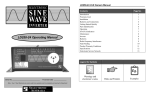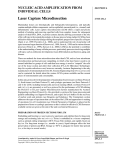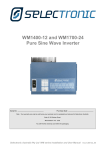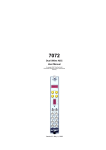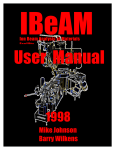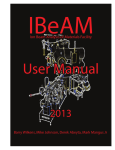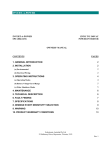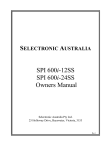Download LD450-12 Owners Manual - Selectronic Australia
Transcript
LD350-12 Volt Owners Manual . LD350-12 Operating Manual Contents Page No. Introduction Warranty Card Installation Batteries and Connections Getting Started Quickly Parts Identification Operation STATUS Indicators Demand Start Setting Low Voltage Shutdown Setting Maintenance Inverter Batteries Handy Hint Radio Frequency Interference Fault Finding Product Warranty Conditions Specifications Selectronic Service Network 1 1 1 4 6 6 7 7 9 10 11 11 11 12 13 14 15 16 Back Cover Legend for Symbols Serial No _____________________________ Purchase Date ______________ Note - Your 2 Year Warranty can only be valid once your warranty card is completed and returned to Selectronic Australia S ELECTRONIC AUSTRALIA Warnings and electrician’s notes Hints and Pointers Examples Introduction Thank you for choosing to purchase the Selectronic LD350-12 TRUE SINE WAVE inverter. Many hours of Research and Development have gone into the LD350-12 to ensure this inverter provides you with many years of reliable service Warranty Card It is imperative that you complete your warranty card NOW. Your LD35012 is covered by a TWO year warranty; this warranty is in addition to your rights under the trade practices act of your state or territory. Returning you completed warranty card will enable us to register your warranty and avoid any possible delays should service be required. If you have any comments about our product that will not fit on the warranty card please feel free to drop us a line. Yes, constructive criticism will also be welcome. Large amounts of DC current can be drawn by your LD350-12, care must be taken. Fixed Installation All fixed installation battery connections must be securely bolted, using stainless steel nuts and bolts. To protect the connection from corrosion smear a small amount of Vaseline or similar over the joint. Never place batteries directly onto a concrete floor, place timber or similar material beneath the batteries. *System Fuse To Load Battery Bank LD350-12 Inverter Installation 200mm 200mm * A system fuse (of at least 40 Amps) should be placed before the battery. An HRC motor start type is recommended. (See your system designer for details). Warning 200mm 200mm LD350-12 Inverter LD350-12 Inverter Front Please leave a clearance of 200mm on all sides and top of the Inverter. The LD350-12 must be installed in a dry, cool, dust-free environment. It is recommended that the inverter be placed as far from any radio receivers as possible. LD350-12 Manual 1 Selectronic Australia As a matter of safety, Selectronic strongly recommend that all fixed installations be designed and installed by appropriately qualified person. The Solar Energy Industries Association in your state or territory can provide names of accredited system designers and installers. The output voltage from an inverter is as lethal as mains electricity. All AC wiring MUST be carried out by an accredited electrician and must conform to AS3000 and/or any relevant local standards. Electrician’s Note • All earth’s AC and DC should be bonded • RFI/Lightning Earth stake should be within 3m of the inverter • The LD350-12 is suitable for connection to MEN wiring • Any AC changeover switch must be a ‘break before make’ type LD350-12 Manual 2 Selectronic Australia Portable Use Batteries and Connections By using optional battery clips, the LD350-12 can be connected directly to a vehicle battery. When using Alligator clips ensure they have a tight grip around the battery post. Wherever possible battery connections should be bolted. If connecting the LD350-12 through a cigarette lighter socket the maximum power output of the LD350-12 will be severely restricted, this practice should be avoided. Check with your supplier or installer if you are unsure. Batteries are the key to maximum performance from your LD350-12, if a battery is too small or not fully charged it may result in de-rated performance from your LD350-12. Do not use alligator clips in a moving vehicle Battery ratings Batteries can be rated in one of two ways: 1. CCA = Cold Cranking Ability. This is the amount of power or current that a battery can deliver for a short period, typically a few seconds. This how a car battery would normally be rated. 2. Ah = Ampere Hours. This is the maximum amount of energy that can be stored in a battery; this figure will generally be stated at a particular hour rate. This is how a deep cycle or storage battery would normally be rated. Start Battery 100Ah @100hr, this means that when this battery is discharged over a period of 100 hours, the battery has a capacity of 100Ah. This in theory means 1 Amp for 100 hours, although this would in practice result in a totally discharged battery that may not then recover. Earth (to chassis) LD350-12 Inverter Isolator Vehicle Alternator To achieve maximum performance from your LD350-12 you must have a battery capable of delivering 150 Amps for a short period whilst maintaining at least 10.5 volts. To increase the capacity of your battery you may need to join more than one battery together. Auxiliary Battery • Earth (to chassis) By incorporating an auxiliary battery in the manner above, the starting battery should remain charged for vehicle starting (see your auto electrician). The LD350-12 has sufficient battery cable length to allow it to sit underneath the vehicle whilst in use. If the ground is wet, place the LD350-12 on a waterproof liner. LD350-12 Manual 3 Selectronic Australia Where batteries are joined in series, add the voltage of each battery. The capacity will equal the capacity of the smallest battery. 2 x 6 Volt 150 Ah batteries connected in series would have a total capacity of 12 Volts – 150 Ah. LD350-12 Manual 4 Selectronic Australia Getting Started Quickly Where batteries are joined in parallel, add the capacities together, the voltage will remain the same as each batteries voltage. 2 x 12 Volt 150 Ah batteries connected in parallel would have a capacity of 12 Volts – 300 Ah. Only use identical batteries when joining batteries together. How long will my battery last To work out how long your battery will last follow this basic guide. This guide presumes commencing with a fully charged battery. Take the total rating of the appliance being run 1 light globe 25watts 1 20 inch TV 67watts 1 VCR 30watts Total load =122watts Divide this figure (122) by 10 to know the approximate DC current draw =12.2Amps To convert this to Ampere hours, multiply by the number of hours used Say 1 hour =12.2Ah So if we have a 150Ah battery, then with the above example we should have 150 minus 12.2 = 137.8 Ah remaining in the battery. As a general guide never discharge a battery below 50%. The deeper a battery is discharged on a regular basis, the less life you can expect from the battery. The Ah rating of a battery will also be reduced if the drain current is greater than the rated discharge current. See your battery specifications for full details. LD350-12 Manual 5 Selectronic Australia If you want to get powered up quickly here are the 11 simple steps. 1. Familiarise yourself with the details in the first 6 pages on this manual. 2. Unpack the LD350-12 from the packaging. 3. Check unit for any damage that may have resulted during transport, if any damage is evident report this to your supplier immediately. 4. Make sure the LD350-12 ON/OFF switch (12) is in the off position. 5. Connect battery positive wire (red) (10) to battery positive or battery fuse. 6. Connect battery neg. wire (black) (11) to battery negative or battery fuse. 7. Plug a 230 - 240V appliance into inverter front power point (8) but do not switch on. 8. Turn ON/OFF switch (12) to ON. 9. After 3 seconds LED (1) will begin to flash. If no LEDs light, check for correct connection to battery. 10. Turn power point (8) on 11. You’re away. LD350-12 Parts Identification LED (1) LED (2) LED (3) LED (4) ON/OFF Switch (12) LED (5) Mode Button (7) (8) Power Point/GPO Positive (Red) Battery lead (6) can be viewed from the rear. Negative (Black) Battery Lead (7) can be viewed from the rear. LD350-12 Manual 6 Selectronic Australia Operation Five LEDs are provided on the front panel to indicate a number of parameters, and allow adjustment of some of these parameters. LED (5) tells you what LED (1) – (4) is displaying as indicated on the front panel of the LD350-12. Pressing Mode Button (7) will change the information being displayed. STATUS indicators LED (5) (green) flashing When power is first applied LED (1) should flash. When LED (5) (green) is OFF, this indicates the LED (1) – (4) is showing the inverters STATUS, as per written notation to the right of the LEDs. In this mode there are no adjustments to be made. LED (1) Flashing indicated the LD350-12 is in Demand Start mode, this indicates that no power is being drawn from the inverter so it has gone to SLEEP to save power. If no power is used within 12 minutes, the LED (1) will flash at a slower rate therefore saving more power. LED (1) Stays ON, the inverter has been commanded to provide power to the load (e.g. a light switch has been turned on) so it has gone from SLEEP mode to ON. Once the load has been removed (e.g. the light switch is turned off) the inverter will wait 10 seconds and return to SLEEP mode. It is good practice to have your LD350-12 in SLEEP mode as often as possible. When the LD350-12 is in SLEEP mode it uses 0.06 amps from the battery, when the inverter is in the ON mode it uses at least 0.50 amps from the battery. LED (2) AC Overload should normally remain OFF. If the inverter shuts down due to too much AC load being drawn from it then LED (2) will come ON. The LD350-12 will remain in this condition for 1 minute after the AC load has been decreased to a safe level. LED (2) will flash if the inverter shuts down due to “time to shutdown”, see page 18 • If the inverter remains in this condition after one minute, switch (12) should be turned OFF and then back ON. LED (3) DC Volts Low / High should normally remain OFF. If the inverter shuts down because the battery volts are too high then this LED (3) will come ON. It will remain ON until normal battery volts are restored. • If the inverter shuts down due to not enough battery volts, then LED (3) will flash. • LED (3) will continue to flash until the battery volts have risen sufficiently. In this case, charge the battery by starting the vehicle or using a battery charger. The low voltage point that the inverter will cut out is adjustable to suit your particular battery, see page 12 for details of this adjustment. LED (4) Temperature Overload should normally remain OFF. If the inverter shuts down due to the heatsink getting too hot, then this LED (4) will come ON. If the transformer is too hot then LED (4) will FLASH. The LED will remain ON or FLASHING until the temperature has lowered to a safe level; the inverter will then come back ON. • If this LED (4) is coming on regularly, either reduce the amount of load on the inverter or try to move the inverter to a cooler location. The amount of power required to go from SLEEP to ON is adjustable and is described on page 11. LD350-12 Manual 7 Selectronic Australia LD350-12 Manual 8 Selectronic Australia Demand Start Adjust LED (5) (green) ON It is sometimes necessary to adjust the demand start sensitivity to overcome what is called “Phantom Loads”. A phantom load is a load that tricks the inverter into thinking it should be ON instead of in SLEEP mode. The wiring of a house or a portable stereo system in standby are good examples of a phantom load. These loads serve no purpose but yet can increase battery drain by bringing the inverter ON. Hold the Mode button (7) down until LED (5) comes ON, (approximately 1 second) indicating you are ready to adjust this setting. The LD350-12 will leave the factory with a setting of 4 watts. Now press the Mode button (7) until the desired value is sought. LEDs (1) – (4) will return to Status after 20 seconds. Demand Start Watts 4 Watts 5 Watts 6 Watts 7 Watts 8 Watts 9 Watts 10 Watts 11 Watts 12 Watts 13 Watts 14 Watts 15 Watts 16 Watts Continuous LED 1 Slow Flash Medium Flash Fast Flash ON ON LED 2 LED 3 Slow Flash Medium Flash Fast Flash ON ON ON ON ON LED 4 Slow Flash Medium Flash Fast Flash ON ON ON ON ON ON ON ON ON ON After “continuous”, the next button press “rolls back” the demand start setting to 4 Watts LD350-12 Manual 9 Selectronic Australia Low Volts Adjust LED (5) (green) FLASHING To avoid total discharging of your battery the LD350-12 shuts down at a preset low voltage. As all batteries are different, so too is the minimum voltage they should be discharged to. The LD350-12 will leave the factory with a setting of 11.0 volts, change this setting if required. Hold the Mode button (7) down until LED (5) is FLASHING, (approximately 2 seconds) indicating you are ready to adjust this setting. Now press the Mode button (7) until the desired value is sought. LEDs (1) – (4) will return to Status after 20 seconds. Low Volts Cut-out 10.0 Volts 10.1 Volts 10.2 Volts 10.3 Volts 10.4 Volts 10.5 Volts 10.6 Volts 10.7 Volts 10.8 Volts 10.9 Volts 11.0 Volts 11.1 Volts 11.2 Volts 11.3 Volts 11.4 Volts 11.5 Volts LED 1 Slow Flash Medium Flash Fast Flash Fastest Flash ON LED 2 Slow Flash Medium Flash Fast Flash Fastest Flash ON ON ON ON ON LED 3 LED 4 Slow Flash Medium Flash Fast Flash Fastest Flash ON ON ON ON ON ON ON ON ON ON After “11.5 Volts”, the next button press “rolls back” the Low DC Volts Cut-out setting to “10.0 Volts” LD350-12 Manual 10 Selectronic Australia Maintenance Inverter Periodic maintenance of your LD350-12 inverter involves little more than checking for any obstructions to the black cooling heatsink at the rear of the inverter. The heatsink must be cleared of any accumulated foreign matter that may have lodged itself between the fins since the last maintenance check, e.g. insect nests. Also verify that airflow around the inverter has not become restricted. Batteries 1. Every week, carry out a thorough visual inspection of all battery wiring, taking particular note of the condition of inter-connections between cells. This maintenance should be carried out in conjunction with the battery manufacturers recommended maintenance. Safety Hint When working on batteries of such high capacity it is essential that you wear protective clothing, some form of eye protection and rubber-soled work boots. Please regard your batteries with a great deal of caution, and if in any doubt, entrust this work to your supplier / installer. 2. 3. Once a fortnight or as directed in your battery manufacturer, check the specific gravity (SG) of each battery cell using a hydrometer, to ensure that all cells are performing correctly and are properly charged. Any serious imbalance should be reported to your system designer in case remedial action needs to be taken. Handy Hints It is very important that you become familiar with the functioning of your inverter. From a distance, it is not always easy to know what if the inverter is On or in Sleep mode. An easy way to determine this is to plug a small child's night-light (neon type) into a power point that is easily visible, or replace this power point with a safety type with a neon indicator. This will indicate the inverter's operation by flashing when the inverter is in SLEEP mode and remaining ON when the inverter is brought ON by a load. Check that the stainless steel inter-connecting bolts are tight and have no corrosion. If corrosion is evident, carefully follow the following procedure. • • • Disconnect the system battery fuse before working on the battery bank. Unbolt the stainless steel bolts and nuts of any corroded connections and thoroughly clean the joint with a wire brush or file, taking extreme care not to short circuit any battery cells with any tools. Re-assemble and smear a small amount of Vaseline or similar grease over the surface of the joint to slow down any future corrosion. LD350-12 Manual 11 Selectronic Australia LD350-12 Manual 12 Selectronic Australia Radio Frequency Interference Fault Finding Radio Frequency Interference (RFI) can be a problem for owners of inverters. RFI in a domestic situation may produce noise or interference on a radio or TV receiver. No indicators ON when power is first applied Considerable development time has resulted in a reduction of the RFI generated by the inverter to a level that complies with C-tick requirements. Compliance to this standard means RFI is low, but how well the inverter performs in a particular installation can vary. Below are some suggestions to help reduce the effects of RFI in your installation; • It is recommended that the power system including the inverter be housed at least 15 metres from the home. • Ensure an earth stake is placed as close to the inverter as possible and connected to the inverter via a short length of wire. See page 2 for wiring details. • Avoid running DC cables into the home, if at all possible. If this cannot be avoided, run DC and AC in separate conduits separated by as much distance as practicable. All DC wiring should also be kept together and be as short as possible. • If your inverter is to be installed in a mobile home or similar, try to keep your inverter at least one metre away from your radio or audio equipment. The further the better. LD350-12 Manual 13 Selectronic Australia When first connected, if the LD350-12 shows no indicators the battery connections may be reversed. Check that the red battery wire (10) is connected to the battery positive, and the black battery wire (11) is connected to the battery negative. Remember there is a 3 second delay before power is available after switch ON. Inverter stays ON when no appliance is being used This can be a common problem known as a “Phantom Load”, but can be easily overcome. Some appliances will need to be switched off at the power point as they may still represent a small load despite being switched off at the appliance. Check again to make sure that there are no appliances left ON, the sequentially switch off appliances at the wall and by watching your night light (as described in Handy Hint, check to see if the LD350-12 returns to pulsing (SLEEP) mode after a 10 second delay. Once you have found the offending appliance, increase the sensitivity of the “Demand Start” (see page 11) until the inverter turns OFF. Once this is done re check that small loads will still bring the inverter ON when required. Inverter shuts down during the middle of the day, and comes back ON late in the afternoon This is more than likely caused by high battery volts during peak charging times from Solar Panels. Battery volts should never exceed 17 volts. If this is the case, have your Solar Regulator checked. LD350-12 Manual 14 Selectronic Australia Product Warranty Conditions LD350-12 Specifications Inverter Type Microprocessor control circuit with PWM full bridge power stage. True sine wave AC output Warranty Current draw from Battery Selectronic Australia Pty Ltd warrants your inverter to be free from defects in materials and workmanship under normal use and service, for an initial period of two (2) years. Defective parts will be replaced or repaired free of charge within this period. Conditions This warranty is applicable only from the date of original purchase. The provision of this warranty shall not apply if the unit has been subject to misuse, neglect, act of God, accidental damage or has been used for a purpose for which it is not intended. Unauthorised modification or repair will void your warranty. To ensure a smooth and speedy response to your warranty claim, please complete and return your reply paid warranty card within 30 days from date of purchase. Condition Amperage Demand Start SLEEP mode (average) Inverter ON, with no Load Maximum Continuous Load (350 Watt) Half hour rating (450 Watt) Surge rating (1000 Watt) 0.06 Amps 0.40 Amps 34 Amps ≈ 45 Amps ≈ 93 Amps. Inverter Power Ratings @ 25º C Condition Total Inverter output Continuous Half hour rating Surge rating (5 seconds) Wattage @ 1.0pf Current 350 Watt 450 Watt 1000 Watt 1.4 Amps ≈2 Amps ≈3.4 Amps Within Australia & New Zealand The inverter must be returned, at the owner’s cost, to an authorised service centre listed in this manual. There will be no charge for the return of the inverter. Demand Start Pulsing AC 4 watts – 16 watts user adjustable 1 second maximum Type Minimum Load to Start Response Time Outside Australia & New Zealand Product purchased for use outside Australia & New Zealand must be returned to Selectronic Australia’s Service Centre to enable warranty claims to be processed. Freight cost to be borne by the customer. No charge will be made for the product return. LD350-12 Manual 15 Selectronic Australia Battery Voltage Range Voltage Low DC Volts Cut Out–10 second delay Low DC Volts Cut In High DC Volts Cut Out–Instantaneous 10 – 11.5 volts user adjustable 12 volt 17 volts LD350-12 Manual 16 Selectronic Australia Miscellaneous Specifications Reverse Polarity Protection Output Voltage Accuracy 0-350 watts Output Frequency Peak Efficiency Total Harmonic Distortion Memory Retention Operating Temperature Range Transformer Type Cooling Method Power Point Chassis Material Chassis Coating Size LD350-12 Manual 17 Full Electronic Protection ± 4% @ 12 volt input 50Hz ± 0.01% 90% <4% Permanent 0º C to 40º C Toroidal Controlled fan-forced 10 Amp Single Pole Zinc Coated Steel Powder Coated 230W x 130H x 260mm D Selectronic Australia Selectronic Authorised Service Network Selectronic Australia 25 Holloway Drive Bayswater Victoria 3153 Australia Ph: 03 9762 4822 Fax: 03 9762 9646 [email protected] Burley TV Service 278 Edmondson Ave. Austral NSW 2171 Australia Ph: 02 9606-0279 Solar Inverter Services 13 Thirteenth Ave. Sawtell NSW 2452 Ph: 02 66581733 Rainbow Power Company 1 Alternative Way Nimbin NSW 2480 Australia Ph: 02 6689 1430 Fax: 02 6689 1109 Reid Technology Ltd 3-5 Auburn Street Takapuna North Shore City Auckland NZ Ph: 9 489-8100 Fax: 9 489-8585 [email protected] S ELECTRONIC AUSTRALIA 25 Holloway Drive Bayswater, Victoria 3153 Australia Phone 03 9762 4822 Fax 03 9762 9646 Email [email protected] Part No ST-M-LD351 REV 2 24/02/04











